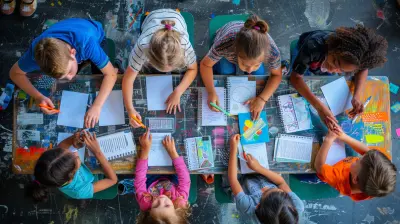Facilitating Inclusive Group Work in Diverse Classrooms
2 November 2025
Group work can be a fantastic way for students to engage, learn, and collaborate. But when you have a classroom filled with students from different backgrounds, abilities, and learning styles, things can get a bit tricky. How do you ensure that every student feels heard, valued, and included?
Inclusive group work is the key to making sure all students contribute meaningfully, no matter their skill level or background. But what does that actually look like in a diverse classroom? Let's break it down.

Why Is Inclusive Group Work Important?
Think of a classroom like a giant puzzle. Every student is a unique piece, and when they fit together just right, they create something beautiful—shared learning experiences. But if some pieces are excluded or don’t quite fit, the puzzle remains incomplete.Inclusive group work encourages collaboration, builds empathy, and develops essential social and problem-solving skills. When done right, it helps students:
- Feel a sense of belonging
- Improve their communication skills
- Learn different perspectives
- Develop teamwork and leadership abilities
By fostering an inclusive environment, educators can ensure that no one is left behind. Sounds great, right? Now, let’s talk about how to make it happen.

Setting the Foundation for Inclusive Group Work
Before students even start working in groups, you need to lay the groundwork. Think of it as preparing the soil before planting seeds. Here’s how:1. Establish Clear Expectations
Students need to understand what’s expected of them in a group setting. Set ground rules for communication, respect, and participation. Emphasize active listening, open-minded discussions, and shared responsibilities.You might say something like:
"In this class, we all contribute. Everyone's voice matters, and we support each other."
2. Create a Safe and Respectful Environment
No one wants to share ideas if they feel judged or ignored. Encourage students to respect different opinions and perspectives. Consider practicing activities where students reflect on their own biases and how they can be more understanding of others.A classroom where students feel safe is one where they’re more willing to engage.
3. Diversify the Groups
If students always work with the same people, they miss out on new perspectives. Mix up groups based on skills, backgrounds, and interests. One way to do this is through strategic pairing—pairing students with different strengths so they complement each other.For instance, if one student is a natural leader and another is shy but detail-oriented, together they can balance each other out.

Strategies for Facilitating Inclusive Group Work
Once your students are set up for success, it’s time to implement strategies that ensure inclusive participation.1. Assign Roles Within the Group
Sometimes, students dominate discussions while others stay silent. To prevent this, assign roles such as:- Facilitator – Keeps the group on task
- Recorder – Takes notes and summarizes discussions
- Timekeeper – Ensures tasks are completed on time
- Encourager – Makes sure everyone’s voice is heard
Having structured roles ensures that responsibilities are shared, preventing one student from taking over while others fade into the background.
2. Use Scaffolding Techniques
Not every student will be at the same academic level. Scaffolding helps by breaking tasks into smaller, manageable parts. Provide guiding questions or sentence starters to help students who might struggle.For example, instead of asking, "What do you think?" try, "Can you explain why you agree or disagree with this idea?" This small tweak encourages deeper thinking and ensures more students participate.
3. Encourage Active Listening and Reflection
Listening is just as important as speaking. Encourage students to paraphrase what their peers say before responding.Try an activity like “Turn and Talk.” One student shares their thoughts, and the other summarizes before adding their own opinion. It ensures that students are truly engaging with one another.
4. Incorporate Visual and Hands-On Activities
Not all students thrive in verbal discussions. Using visual aids, manipulatives, or even role-playing can help diverse learners engage more deeply.For example, if students are working on a history project, some might prefer to create a visual timeline, while others might write a script for a reenactment. Giving them options makes the group work more inclusive.
5. Address Conflicts Constructively
Let’s be real—group work isn’t always smooth sailing. Disagreements happen, and that’s okay. The important thing is teaching students how to navigate conflicts respectfully.Set up a simple conflict-resolution framework:
- Step 1: Listen to all sides
- Step 2: Acknowledge different viewpoints
- Step 3: Find common ground
- Step 4: Work toward a fair solution
By modeling this approach, you teach students valuable conflict-resolution skills that go beyond the classroom.
6. Provide Individual Accountability
Group work shouldn’t mean that one person does all the work while others slack off. Hold students accountable by incorporating peer evaluations or self-reflections.Ask questions like:
- Did everyone contribute equally?
- What did you learn from working with your group?
- How could the group work better next time?
This keeps students aware of their responsibilities and ensures fairness in workload distribution.

Real-Life Benefits of Inclusive Group Work
When students experience inclusive group work, they carry those skills into the real world. Imagine working in a diverse workplace—those same teamwork, communication, and problem-solving skills will be crucial.Plus, students develop empathy and understanding. They learn that different perspectives don’t divide us; they make us stronger.
Challenges and How to Overcome Them
Of course, there will be hurdles. Some students might feel left out, some might overpower discussions, and others might not engage at all. Here’s how to tackle common challenges:| Challenge | Solution |
|-----------|----------|
| Students feeling excluded | Rotate roles to ensure equal participation. |
| One student dominating conversations | Use "talking tokens" where each student gets a limited number of turns to speak. |
| Lack of engagement | Connect tasks to students' interests or allow them to present their work in different formats. |
| Language barriers | Pair multilingual students with those who can support them, and use visual aids to bridge communication gaps. |
Final Thoughts
Creating an inclusive classroom isn’t just about seating arrangements or group activities. It’s about fostering a culture where every student feels seen, heard, and valued.When students experience truly inclusive group work, they don’t just complete assignments—they develop life skills that benefit them far beyond the classroom walls.
So, the next time you're planning group work, take a moment to ask yourself: Is every student getting a fair chance to contribute? If not, a few small changes could make all the difference!
all images in this post were generated using AI tools
Category:
Group WorkAuthor:

Fiona McFarlin
Discussion
rate this article
1 comments
Adeline Wells
This article beautifully highlights the importance of fostering inclusivity in group work. By embracing diverse perspectives, we can create a richer learning environment that benefits all students. Thank you for shedding light on this vital topic!
November 2, 2025 at 12:16 PM

Fiona McFarlin
Thank you for your kind words! I'm glad the article resonated with you and emphasized the value of inclusivity in group work.


